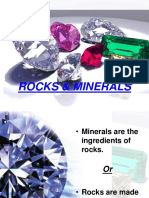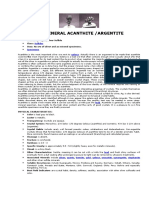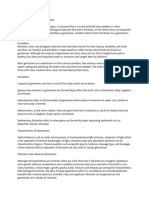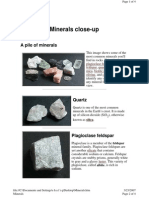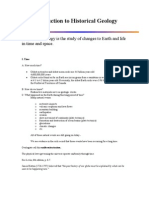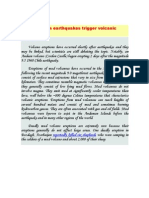0 ratings0% found this document useful (0 votes)
38 viewsQuartz: - : Granite Diorite Andestie Rhyolite Gabbro Basalt
Quartz: - : Granite Diorite Andestie Rhyolite Gabbro Basalt
Uploaded by
api-3808551Quartz is a common mineral composed of silicon dioxide that is found in light-colored igneous rocks such as granite and rhyolite but not in mafic rocks like gabbro and basalt. It is usually clear but can be white, gray, dark smoky or colored varieties like rose quartz. Quartz has a hexagonal crystal structure and commonly forms six-sided pyramid shapes with striations on the faces. Due to its resistance to weathering, quartz accumulates in metamorphic rocks, beach sand, and soil.
Copyright:
Attribution Non-Commercial (BY-NC)
Available Formats
Download as PDF, TXT or read online from Scribd
Quartz: - : Granite Diorite Andestie Rhyolite Gabbro Basalt
Quartz: - : Granite Diorite Andestie Rhyolite Gabbro Basalt
Uploaded by
api-38085510 ratings0% found this document useful (0 votes)
38 views1 pageQuartz is a common mineral composed of silicon dioxide that is found in light-colored igneous rocks such as granite and rhyolite but not in mafic rocks like gabbro and basalt. It is usually clear but can be white, gray, dark smoky or colored varieties like rose quartz. Quartz has a hexagonal crystal structure and commonly forms six-sided pyramid shapes with striations on the faces. Due to its resistance to weathering, quartz accumulates in metamorphic rocks, beach sand, and soil.
Original Title
Q u a rtz
Copyright
© Attribution Non-Commercial (BY-NC)
Available Formats
PDF, TXT or read online from Scribd
Share this document
Did you find this document useful?
Is this content inappropriate?
Quartz is a common mineral composed of silicon dioxide that is found in light-colored igneous rocks such as granite and rhyolite but not in mafic rocks like gabbro and basalt. It is usually clear but can be white, gray, dark smoky or colored varieties like rose quartz. Quartz has a hexagonal crystal structure and commonly forms six-sided pyramid shapes with striations on the faces. Due to its resistance to weathering, quartz accumulates in metamorphic rocks, beach sand, and soil.
Copyright:
Attribution Non-Commercial (BY-NC)
Available Formats
Download as PDF, TXT or read online from Scribd
Download as pdf or txt
0 ratings0% found this document useful (0 votes)
38 views1 pageQuartz: - : Granite Diorite Andestie Rhyolite Gabbro Basalt
Quartz: - : Granite Diorite Andestie Rhyolite Gabbro Basalt
Uploaded by
api-3808551Quartz is a common mineral composed of silicon dioxide that is found in light-colored igneous rocks such as granite and rhyolite but not in mafic rocks like gabbro and basalt. It is usually clear but can be white, gray, dark smoky or colored varieties like rose quartz. Quartz has a hexagonal crystal structure and commonly forms six-sided pyramid shapes with striations on the faces. Due to its resistance to weathering, quartz accumulates in metamorphic rocks, beach sand, and soil.
Copyright:
Attribution Non-Commercial (BY-NC)
Available Formats
Download as PDF, TXT or read online from Scribd
Download as pdf or txt
You are on page 1of 1
Quartz: -
quartz, (pronounced: kwarts)
Crystalline quartz or low quartz, (SiO2) is a common and
diagnostic mineral in light-colored felsic igneous rocks, such
as granite, diorite, andestie, and rhyolite. Quartz is almost
never found in mafic rocks such as gabbro and basalt.
It is usually clear, but in granite it is also cloudy white or
greyish in color. It can also be dark (as in smokey quartz). Many
gemstones are actually less common colored varieties of quartz.
Examples include purple amythest, yellow citrine, and pink rose
quartz. Quartz is also common in metamorphic rocks such as gneiss.
Because quartz is so resistant to weathering due to its chemical
composition and atomic bonds, it accumulates as the other minerals
in a rock weather away. Light colored beach, aeolian and alluvial
sand is composed of mainly quartz grains.
Quartz in it characteristic crystal form has a hexagonal shape. In
cross-section it has six sides. Commonly the ends of quartz crystals
are teminated by six-sided pyramids. This type of crystal form is
seen in the picture of quartz above. Also seen in the picture are the
fine striations across the crystal faces.
You might also like
- Amsh7199 ObsDocument11 pagesAmsh7199 Obsnativeamrc100% (2)
- 1.what Is Quartz ? Where Can It Be Found ? Formation of QuartzDocument12 pages1.what Is Quartz ? Where Can It Be Found ? Formation of QuartzNguyễn Đăng Minh100% (1)
- EESC 1101 - Lab 4 - Brooklyn College Building Stone PDFDocument13 pagesEESC 1101 - Lab 4 - Brooklyn College Building Stone PDFLorenzo YapNo ratings yet
- Effect of Alloying Element in Tool SteelDocument2 pagesEffect of Alloying Element in Tool Steelvikrant GarudNo ratings yet
- Earth Science: Submitted By: Christian D. Gonzales Marjorie Q. ReformaDocument38 pagesEarth Science: Submitted By: Christian D. Gonzales Marjorie Q. ReformaLauriLeighQuevadaZumárragaNo ratings yet
- Study of Rock-Forming MineralsDocument50 pagesStudy of Rock-Forming MineralsAlmira Legion PisngotNo ratings yet
- RotoinversionDocument3 pagesRotoinversionzrie premesNo ratings yet
- Geology For Civil EngineersDocument41 pagesGeology For Civil EngineersChrysel MarieNo ratings yet
- Common Rock Forming MineralsDocument4 pagesCommon Rock Forming MineralsClyde Chloe D. Traya100% (1)
- Life Earth ScienceDocument10 pagesLife Earth Sciencericardorizajen544No ratings yet
- Minerals Their Uses and OccurenceDocument9 pagesMinerals Their Uses and OccurencepriyanshuNo ratings yet
- Names: (De) (En)Document4 pagesNames: (De) (En)Batul BjartskularNo ratings yet
- Igneous, Sedimentary and Metamorphic RocksDocument22 pagesIgneous, Sedimentary and Metamorphic RockstatskoplingNo ratings yet
- Minerals CompressedDocument61 pagesMinerals CompressedHannah Joy Arrianne PascualNo ratings yet
- Minerals of Igneous RocksDocument5 pagesMinerals of Igneous RocksKung KritsanaNo ratings yet
- Rock TypesDocument33 pagesRock Typesmostafahawa4No ratings yet
- Rock in Thin SectionDocument7 pagesRock in Thin SectionMuhammad Rizal Pahlevy100% (1)
- Chapter 2 - MineralogyDocument7 pagesChapter 2 - Mineralogytaniya paliwalNo ratings yet
- Tri State Minerals A Basic GuideDocument7 pagesTri State Minerals A Basic GuideChristopher WisemanNo ratings yet
- The Identification of Rocks: I. Classification of Igneous Rocks Textures of Igneous RocksDocument10 pagesThe Identification of Rocks: I. Classification of Igneous Rocks Textures of Igneous RocksRafeh KhanNo ratings yet
- Methods Used To Identifying Minerals: CrystalsDocument3 pagesMethods Used To Identifying Minerals: CrystalsMax SinghNo ratings yet
- Mineralogy 1Document23 pagesMineralogy 1Rhealyn RomeroNo ratings yet
- Identifikasi MineralDocument96 pagesIdentifikasi Mineralbudi91086No ratings yet
- Chalcedony 1Document12 pagesChalcedony 1Dinda Azkiya AnindhitaNo ratings yet
- Garnet - Rock-Forming MineralsDocument16 pagesGarnet - Rock-Forming MineralsMelroy DsouzaNo ratings yet
- 11 Geography Notes 05 Minerals and RocksDocument10 pages11 Geography Notes 05 Minerals and RocksAkash100% (1)
- Rocks and Minerals - 1405305940Document224 pagesRocks and Minerals - 1405305940Anyak2014100% (6)
- Earth and Life Lesson 3 MineralsDocument36 pagesEarth and Life Lesson 3 MineralsMagdalena TagubaNo ratings yet
- Examining Minerals and RocksDocument27 pagesExamining Minerals and RocksminingnovaNo ratings yet
- Quartz - Fair 22.07.09Document3 pagesQuartz - Fair 22.07.09riturajgarhia1969No ratings yet
- Types of RocksDocument5 pagesTypes of RocksJeid MakieNo ratings yet
- Types of RocksDocument102 pagesTypes of RocksAlida CrisNo ratings yet
- FeldsparDocument11 pagesFeldsparمحمد حسينNo ratings yet
- GraniteDocument4 pagesGraniteNathaniel AngueNo ratings yet
- Chapter 3Document31 pagesChapter 3Sameer MahatoNo ratings yet
- 90032444261Document2 pages90032444261rahulNo ratings yet
- Mineral SheetsDocument35 pagesMineral SheetsJohn Israel R. CatedralNo ratings yet
- Sedimentary RocksDocument49 pagesSedimentary RocksAnonymous JGegGBF6100% (1)
- Gemstone: Gemology and Jewelry PortalDocument8 pagesGemstone: Gemology and Jewelry PortalNurzamzami IsmailNo ratings yet
- Military Soils Engineering Ch1Document25 pagesMilitary Soils Engineering Ch1GnabBangNo ratings yet
- Igneous Metamorphic Sedimentary Rock GalleryDocument5 pagesIgneous Metamorphic Sedimentary Rock GallerySoleh SundavaNo ratings yet
- AgateDocument6 pagesAgateMarina Mukadi100% (1)
- Rocks Under MicroscopeDocument7 pagesRocks Under MicroscopeShachin ShuklaNo ratings yet
- Mineral ADocument42 pagesMineral ASetya WibawaNo ratings yet
- A Brief Explanation On GemstonesDocument2 pagesA Brief Explanation On GemstonesHakan UçarNo ratings yet
- W11-Stratigraphy Table 3.1Document2 pagesW11-Stratigraphy Table 3.1Bobby WskNo ratings yet
- A Guide to Birthstones - A Collection of Historical Articles on the Gemstones Linked to AstrologyFrom EverandA Guide to Birthstones - A Collection of Historical Articles on the Gemstones Linked to AstrologyNo ratings yet
- Little Rocks & Small Minerals! | Rocks And Mineral Books for Kids | Children's Rocks & Minerals BooksFrom EverandLittle Rocks & Small Minerals! | Rocks And Mineral Books for Kids | Children's Rocks & Minerals BooksRating: 4 out of 5 stars4/5 (1)
- Crystal Basics Pocket Encyclopedia: The Energetic, Healing, and Spiritual Power of 450 GemstonesFrom EverandCrystal Basics Pocket Encyclopedia: The Energetic, Healing, and Spiritual Power of 450 GemstonesRating: 5 out of 5 stars5/5 (1)
- Faceted Gems - A Historical Article on the Methods and Equipment Used in LapidaryFrom EverandFaceted Gems - A Historical Article on the Methods and Equipment Used in LapidaryNo ratings yet
- Tourmaline Gemstones - A Collection of Historical Articles on the Origins, Structure and Properties of TourmalineFrom EverandTourmaline Gemstones - A Collection of Historical Articles on the Origins, Structure and Properties of TourmalineNo ratings yet
- Ruby Gemstones - A Collection of Historical Articles on the Origins, Structure and Properties of the RubyFrom EverandRuby Gemstones - A Collection of Historical Articles on the Origins, Structure and Properties of the RubyRating: 5 out of 5 stars5/5 (1)
- The Cutting, Setting and Engraving of Precious Stones - A Historical Article on Working GemstonesFrom EverandThe Cutting, Setting and Engraving of Precious Stones - A Historical Article on Working GemstonesNo ratings yet
- ArshadDocument1 pageArshadapi-3808551No ratings yet
- Personal CV ShafiqDocument2 pagesPersonal CV Shafiqapi-3808551No ratings yet
- CV BilalDocument2 pagesCV Bilalapi-3808551No ratings yet
- Earthquakes & Earth's InteriorDocument14 pagesEarthquakes & Earth's Interiorapi-3808551No ratings yet
- MagmaDocument4 pagesMagmaapi-3808551No ratings yet
- Rock Cycle and Rock Cycle AnswersDocument4 pagesRock Cycle and Rock Cycle Answersapi-3808551100% (2)
- Amin CVDocument5 pagesAmin CVapi-3808551100% (1)
- Weathering Sedimentary RocksDocument10 pagesWeathering Sedimentary Rocksapi-3808551100% (2)
- Geology Definition and Much More From Answers - ComDocument10 pagesGeology Definition and Much More From Answers - Comapi-3808551No ratings yet
- MineralsDocument3 pagesMineralsapi-3808551No ratings yet
- Tectonic PlatesDocument6 pagesTectonic Platesapi-3808551No ratings yet
- Introduction To Historical GeologyDocument5 pagesIntroduction To Historical Geologyapi-38085510% (1)
- FaultDocument5 pagesFaultapi-3808551100% (1)
- Earthquake Questions and Answers: What Is An Earthquake?Document15 pagesEarthquake Questions and Answers: What Is An Earthquake?api-3808551No ratings yet
- ArshadDocument1 pageArshadapi-3808551No ratings yet
- The Structure of The EarthDocument3 pagesThe Structure of The Earthapi-3808551No ratings yet
- Class 1 Overview of Physical GeologyDocument5 pagesClass 1 Overview of Physical Geologyapi-3808551No ratings yet
- My New Latest CVDocument1 pageMy New Latest CVapi-3808551100% (1)
- The University of Melbourne - MineralsDocument13 pagesThe University of Melbourne - Mineralsapi-3808551No ratings yet
- TOPTENDocument4 pagesTOPTENapi-3808551No ratings yet
- Ore - Wikipedia, The Free EncyclopediaDocument2 pagesOre - Wikipedia, The Free Encyclopediaapi-3808551No ratings yet
- Can Earthquakes Trigger Volcanic Eruptions ! - VolcanoDocument1 pageCan Earthquakes Trigger Volcanic Eruptions ! - Volcanoapi-3808551No ratings yet
- Bio Data and CV - ShafiqDocument1 pageBio Data and CV - Shafiqapi-3808551No ratings yet
- FaultDocument5 pagesFaultapi-3808551100% (1)
- Hollow Earth DiagramDocument1 pageHollow Earth Diagramapi-3808551No ratings yet
- The Birth of A GlacierDocument1 pageThe Birth of A Glacierapi-3808551No ratings yet
- Igneous Rock TexturesDocument5 pagesIgneous Rock Texturesapi-3808551No ratings yet
- Lloyds Approved Plate ManufacturerDocument82 pagesLloyds Approved Plate ManufacturerUTTAM JAINNo ratings yet
- Astm A216-A216m 2008Document4 pagesAstm A216-A216m 2008Guilherme de BarrosNo ratings yet
- Price List Acp SevenDocument1 pagePrice List Acp SevenJack SanNo ratings yet
- Sintering Mechanisms of Porcelain Stoneware Tiles: Castell6N (Spain)Document13 pagesSintering Mechanisms of Porcelain Stoneware Tiles: Castell6N (Spain)volkanNo ratings yet
- ASTM B275-05 Codification of Certain Metals and AlloysDocument7 pagesASTM B275-05 Codification of Certain Metals and AlloysDemian LópezNo ratings yet
- Hydro-Catalogue-08 09 2020Document74 pagesHydro-Catalogue-08 09 2020Prince MiwaNo ratings yet
- McKissick Overhaul BallsDocument1 pageMcKissick Overhaul BallsYADAGIRI REDDYNo ratings yet
- Placer Deposits: Submitted By: Bhaskarjyoti Rajkhowa, 5 Sem, Roll No.-07Document2 pagesPlacer Deposits: Submitted By: Bhaskarjyoti Rajkhowa, 5 Sem, Roll No.-07Day 2 DayNo ratings yet
- The Bayer Process Was Invented and Patented in 1887 by Austrian Scientist Karl Josef BayerDocument3 pagesThe Bayer Process Was Invented and Patented in 1887 by Austrian Scientist Karl Josef Bayeracanis1016100% (1)
- Pitting CorrosionDocument29 pagesPitting Corrosionatikahj_3No ratings yet
- Nontraditional MachiningDocument32 pagesNontraditional MachiningMustafa Bilge AydoğduNo ratings yet
- HyperionDocument4 pagesHyperionBhargavNo ratings yet
- ANJANA in Ayurveda: Dr. Amit ManeDocument50 pagesANJANA in Ayurveda: Dr. Amit ManeDrVikas67% (3)
- Piston Ring PDFDocument3 pagesPiston Ring PDFArun SNo ratings yet
- Nabl Index - PHP C Search&m Searchlabcertificate&cno 1010Document1 pageNabl Index - PHP C Search&m Searchlabcertificate&cno 1010bmenishant.rmsclNo ratings yet
- Oferta de Cátodo de Cobre PUHER EXTENS S.L.Document3 pagesOferta de Cátodo de Cobre PUHER EXTENS S.L.Mauricio Henriquez MesaNo ratings yet
- Introduction To Industrial Arts Part 2Document17 pagesIntroduction To Industrial Arts Part 2Azura FuchNo ratings yet
- Aalco CatalogueDocument92 pagesAalco CatalogueJason LimNo ratings yet
- Material DatabaseDocument36 pagesMaterial DatabaseChenthil Kumar KNo ratings yet
- Aerospace Metals PDFDocument324 pagesAerospace Metals PDFESAVENo ratings yet
- Study of Mechanical Properties in A Weld Bead of Dissimilar MetalsDocument6 pagesStudy of Mechanical Properties in A Weld Bead of Dissimilar MetalslckvNo ratings yet
- Formulas HeringerDocument92 pagesFormulas HeringerJuliano DeghaidNo ratings yet
- Minerals - RocksDocument67 pagesMinerals - RocksChandramala ANo ratings yet
- Concepton Ellingham Diagram MetallurgyDocument18 pagesConcepton Ellingham Diagram MetallurgyArindam GoswamiNo ratings yet
- Accelerated Cooling of Steel Plates The Time Has CDocument8 pagesAccelerated Cooling of Steel Plates The Time Has CZulfa Ilham BasyarahilNo ratings yet
- 60-0 75ga8Document4 pages60-0 75ga8EsakkirajaNo ratings yet
- Stainless Steel Bars and Shapes': Standard Specification ForDocument7 pagesStainless Steel Bars and Shapes': Standard Specification ForSofiaJabadanEspulgarNo ratings yet
- Effect of The Ti/N Ratio On The Hardenability and Mechanical Properties of A Quenched-and-Tempered C-MN-B SteelDocument9 pagesEffect of The Ti/N Ratio On The Hardenability and Mechanical Properties of A Quenched-and-Tempered C-MN-B SteelanukrithikaNo ratings yet














